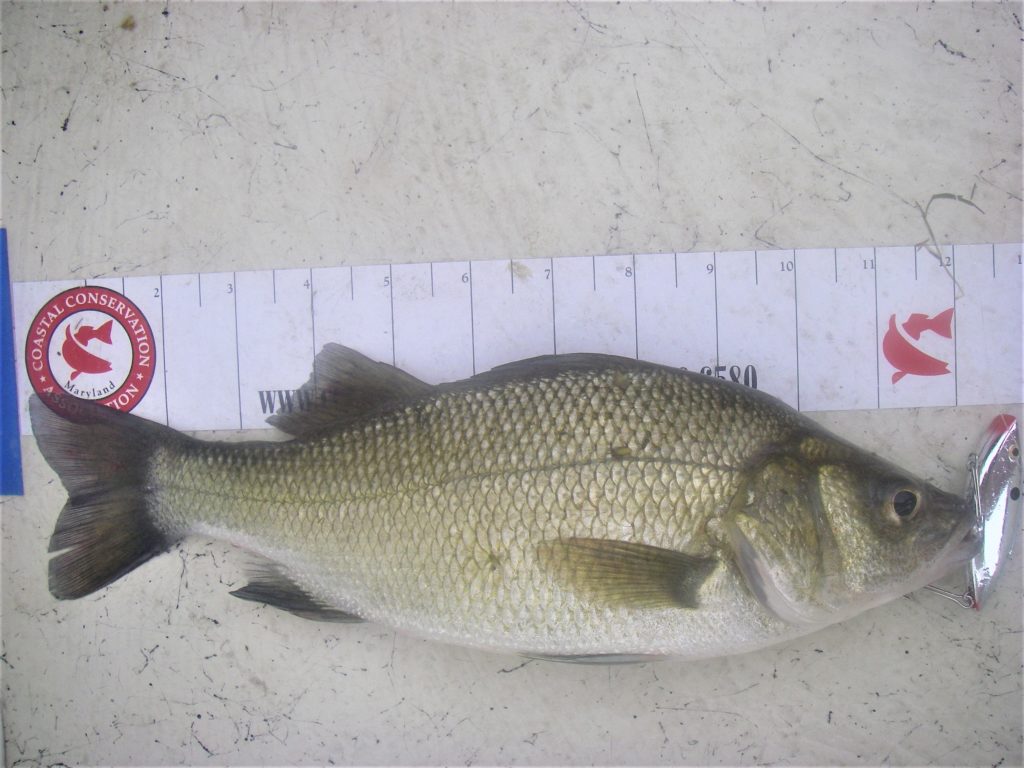Seeking the Right-Sized White Perch

By Dennis Doyle
One of the more difficult trophies to take on the Chesapeake Bay is a citation-sized white perch. They’re unusually scarce and can be pretty crafty, especially in the mid-Bay area. I have a few tips that can improve your chances of scoring a 13-inch-plus beauty.
The first is to search out fishing areas that don’t get many anglers. It can take more than six or seven years, and often over 10, to produce a citation-sized fish. White perch can live over 17 years in the Bay but get a lot of pressure from both recreational and commercial anglers. It is the most frequently harvested species in the Chesapeake as well as the most delicious. Looking where most people don’t can be an advantage. The Maryland Bay record is 2.6 pounds but in recent years a 10-incher is commonly considered a big perch.
Beginning early in the day is often an advantage as the earliest bite is best but it usually dies off by noon though it can pick up again toward dusk. My biggest whitey came on a white 1/0 Clouser Minnow at 10 p.m. one evening near a Sandy Point stone jetty. I was in a canoe casting a fly rod for rockfish. It was early in my Bay angling career and when I released it, irritated that the fish wasn’t a striper, I didn’t know that I’d never see another white perch of that size again—though I’d eventually get some up to 14 inches.
The key for bigger perch is bait. Smaller whites, up to 10 inches, will eat anything, including worms of all types, clams, any kind of shrimp, artificial bloodworms and blue crab—soft, paper shell and peeler. The bigger perch though seem to prefer crabs to all else. Those smaller fish though will often eat up your bait supply before any big ones can be located. Move locations if the sizes aren’t immediately encouraging.
Another good tip is that when choosing soft crab baits, the tougher the soft shell is means the harder it is for perch to steal.
Big perch like deeper waters during summer months, especially around structures of all types; bridge supports are likely areas, and deep water boat berths can harbor big black backs. So can boat houses and boulder-built jetties. Fish your baits close to the structure. Look for unusual areas to try—perch will return and hold in the same general locality for years and if they aren’t chased out by predators or caught can grow to pleasing lengths.
A hook size of 1/0 will allow the use of bigger chunks of crab and minimize hooking up the tiny perch but it’s also wise to use a clear, flexible bait thread or fine netting such as Atlas Mike’s Spawn Net, to reinforce the bait and discourage the thieves. Ordinarily a size 4 hook is used for this small-mouthed species but will be too small for the lunkers and can easily tear out of their delicate mouth structure.
Read your fish finder closely. The units are very good these last few years and if you pay attention and look hard, you can often tell when you’re over larger perch. Remember, when you do start to hook up big perch from a certain area, don’t work that spot too hard or too often. If you clean out a location they may not build back up there for a very long time. Smaller perch taste just as good as the big ones.
Those intent on casting artificial baits up in the tributaries will find that those in the ¼-ounce size, including spinner baits and crank baits, will deliver the better fish. I especially like chromed Rat-L-Trap plugs, Captain Bert’s Perch Pounders and Super Rooster Tails. Any similar type clones will undoubtedly work as well but these are my favorites in depths up to 6 feet or so.
Deeper waters suggest small metal jigs such as Kastmasters, Clarkspoons, Silver Buddies, Pline minnows, Shimano Snipers and their ilk. Casting and bouncing the lures across the bottom will often get surprisingly good results, particularly early morning and evenings.
Working the bottom under a breaking school of fish of all species can produce surprisingly big single perch, as I’ve said they’re a clever lot.
—
White Perch Open Fishing Tournament, Aug. 14 at Podickory Point Yacht Club: Prizes for first, second and third, for children and adults, for the three heaviest white perch, plus an award for the longest. Fishing begins at 5:30am, weigh-ins start at 2:30pm, party noon-5pm. Complimentary t-shirts, BBQ, and beverages. See anglerssportcenter.com for details.
